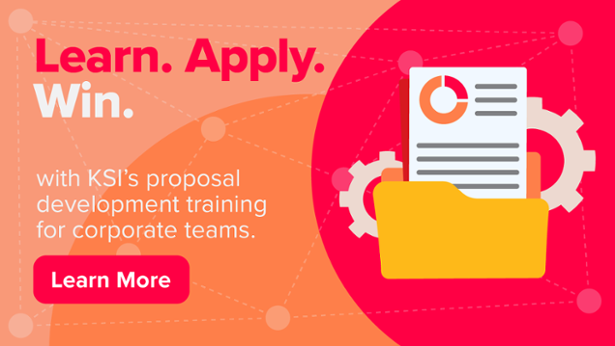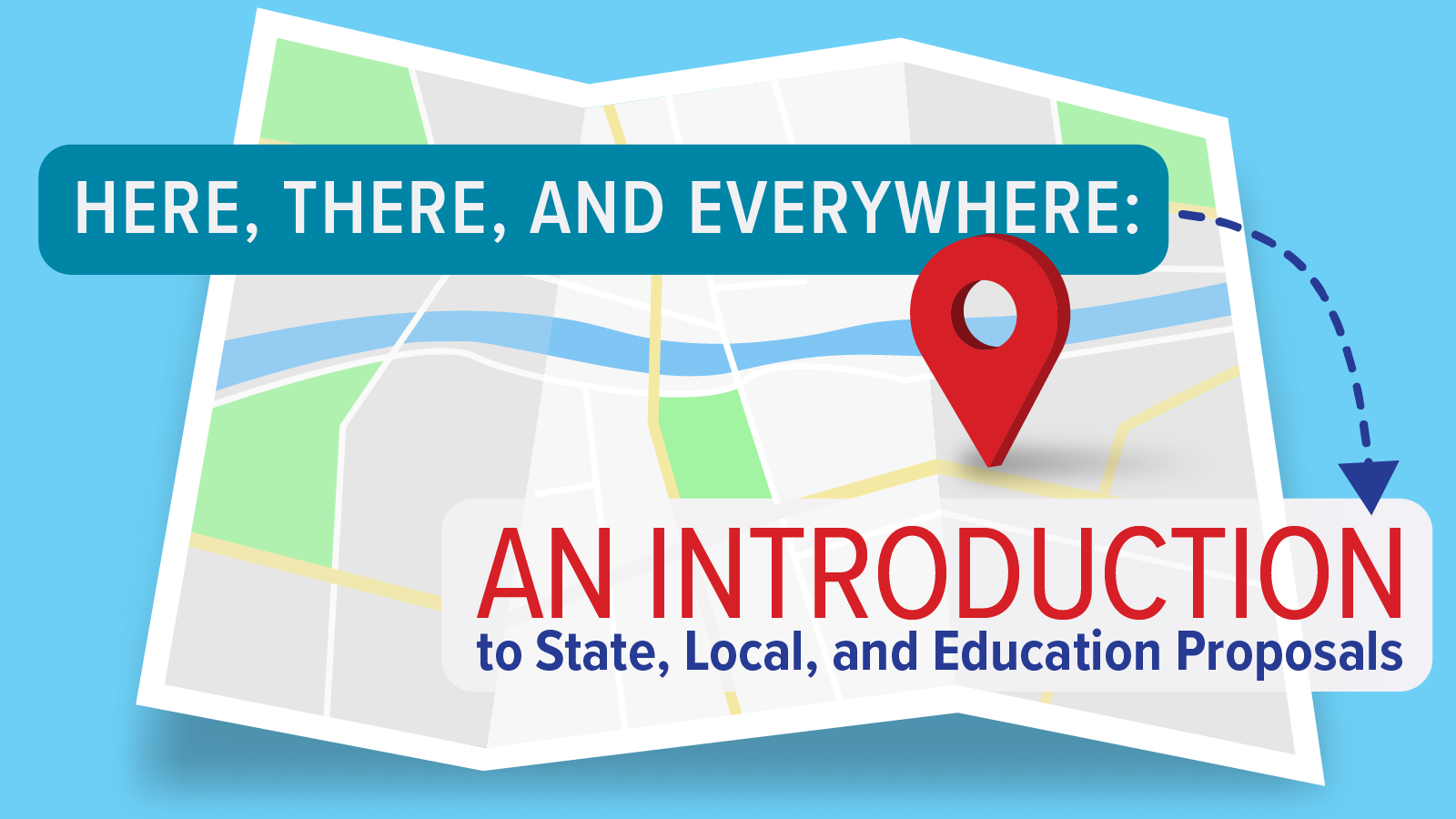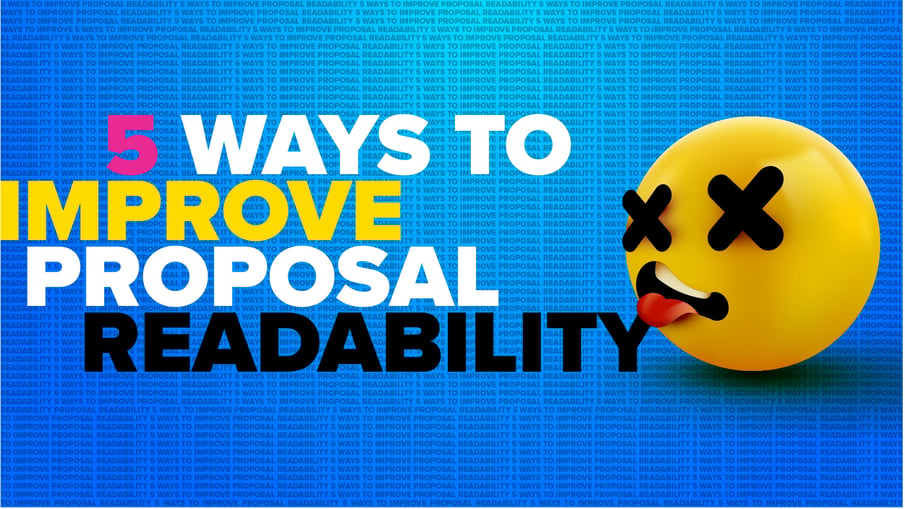
In proposals, clear writing is critical to ensuring the evaluators understand your message. Even if you have the most valuable solution, if you can’t clearly articulate it, you won’t have a high chance of winning the work. Why is this the case? Because it’s simply difficult to score a proposal that is hard to understand.
In this article, we present five ways to improve the readability of your proposals so evaluators can understand your solution and score you appropriately:
- Make your proposal easy to scan
- Simplify your word choice
- Use active voice
- Shorten your content
- Leverage built-in readability functions in Microsoft Word
1. Make Your Proposal Easy to Scan
Simply put, all proposals are scored.
Therefore, when writing proposals, you need to present the information in a way that is easy for evaluators to score. As confirmed by a former Source Selection Authority (SSA) at APMP Bid and Proposal Con 2021, most evaluators do not volunteer for the job, and they do not particularly enjoy it. It takes time away from their regular job, so they want to finish it as quickly as possible. Therefore, you should aim to make the evaluator’s job as easy as possible. One way you can do this is by making the document easy to scan.
You can make a document easy to scan by using:
- Strategic headings and subheadings
- Graphics, tables, and lists to simplify complex material
- Titles and action captions for graphics and tables
Headings and subheadings create a hierarchical representation and help to add visual structure to your document. Without this visual structure, evaluators cannot easily navigate through the document.
Strong headings and subheadings help evaluators:
- Grasp the content at a glance
- Skip what they’re not interested in
- Find what they’re looking for
To make your sections easy to scan and score, structure your response to the proposal instructions and the evaluation criteria. Next, map in other requirements (e.g., elements of the statement of work). To facilitate evaluation, consider including relevant RFP references in your section heading titles. This helps evaluators understand the logic of your organization and map your responses back to their evaluation scoresheet.
Other best practices for headings and subheadings include:
- Make the headings and subheadings stand out visually. Ways to do this include making the text bold and/or applying a different color, font, and/or size.
- Keep headings short. Readers see the first two words of a sentence or phrase most clearly. Consider starting headings and subheadings with key words from the RFP.
- Start headings with section-significant words. Readers tend scan down the left margin. Put the most important RFP words where they’re likely to see them.
How to create run-in headings. One benefit of applying heading styles in Word is that the heading and subheadings will be rolled up into the Table of Contents. However, sometimes we may want to use a run-in heading to save space.
But did you know you can still apply heading styles to run-in headings, so they appear in your Table of Contents? To do so:
- Apply your heading style to your heading text and hit enter
- Apply the body text style to the text you want to run into the heading
- Place your cursor after the heading and hit ctrl + alt + enter
Use Graphics, Tables, and Lists to Simplify Complex Material
Another way to improve the readability of your proposal content is to use graphics, tables, and lists to simplify complex material. They can also add emphasis to important points as well as break up large blocks of text. These factors all serve to improve the clarity of your proposal content.

Graphics. We’ve all heard the old adage, “A picture [or graphic] is worth a thousand words.” If used correctly, graphics are compelling, easy to understand, informative, and help to communicate your message faster and more clearly than words alone. Graphics can help evaluators to easily read data, understand processes, and identify patterns or potential opportunities.
Examples of common proposal graphics include tables, hot boxes/callout boxes, photographs, process diagrams, organization charts, and icons. A good general rule of thumb is to aim for a graphic on every other page. If you can place a graphical element on every page, that is ideal.
Four things to consider when using graphics in proposals include:
- Keep them simple: evaluators should understand your key message in 10 seconds or less
- Keep them uncluttered: be sure to use appropriate line spacing and negative space to maintain the readability of graphics
- Keep them consistent: use a consistent color scheme and style across your graphics
- Keep them meaningful: use graphics that support your narrative and messaging.

Tables. Use tables to organize and display information in columns and rows. Tables make it easy to compare pairs of related values (e.g., cost savings over several months). However, tables are not exclusively used to display quantitative information! Whenever you have more than one set of values with a direct relationship, you can use a table to organize the information. For example, in proposals we frequently use tables to display roles and responsibilities.
Lists. Use lists to simplify text and emphasize key points. Bullets help break down walls of words and enable evaluators to scan the content easily and quickly. Numbered lists accomplish the same goal. They are similarly easy on the eyes and are useful for providing step-by-step instructions. But be careful not to overuse lists. Using too many lists will make it difficult for evaluators to identify key ideas and follow the flow of the response.
Parallel Structure. It’s important to use parallel structure in your lists and tables. Parallel structure is the repetition of a chosen grammatical form within a sentence or list. You should take care to ensure that each item in the list has the same structure. To be parallel, each item in the list should start with the same part of speech, use the same verb tense, use the same voice, and use the same sentence/clause type. Parallel structure is easier for readers to process because they are primed for the pattern of the information.
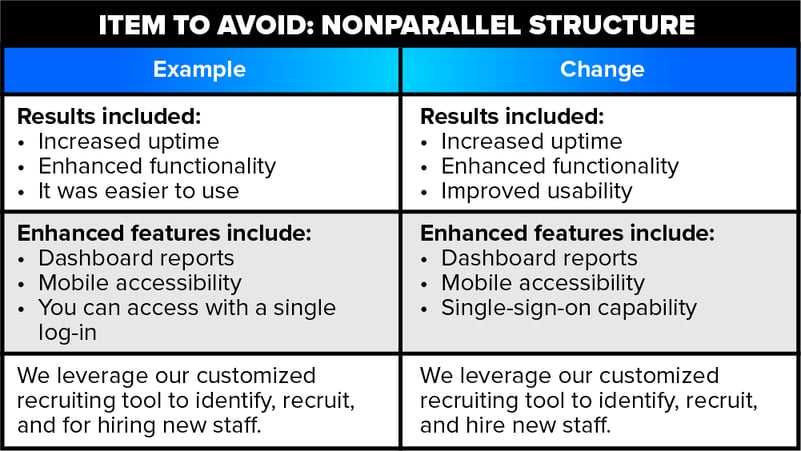
Use Titles and Action Captions for Graphics and Tables
Titles and action captions are another tool to help evaluators scan proposal content more easily. Writers should name each graphic and include an action caption. Action captions help the reader understand the meaning of the graphic and sell the approach, indicating a key feature and customer benefit highlighted in the graphic.
For example, a graphic depicting the interfaces between the Project Team and the customer might carry a caption such as the following:

2. Simplify Your Word Choice
Writers sometimes feel the urge to add emphasis to their prose by using extra words or phrases that don’t contribute much to the meaning (and sometimes obscure it).
Simplifying your word choice clarifies your content and improves readability. Using simple words and phrases will make your writing clearer so that the evaluators can easily understand your message and score you appropriately. To simplify your proposal content:
- Remove redundancies
- Delete unnecessary modifiers
- Check for prepositions
- Use strong verbs
Remove Redundancies
Redundancies add extra words that can obscure your message rather than add value. Look for common redundant phrases that take up space but don’t add value. Removing redundancies will help make your writing clearer and more concise, which in turn will make it easier to evaluate.

Delete Unnecessary Modifiers
We often use modifiers like absolutely, actually, completely, really, quite, totally, and very. But if you look closely, you’ll find that they’re probably not necessary and may even be nonsensical.
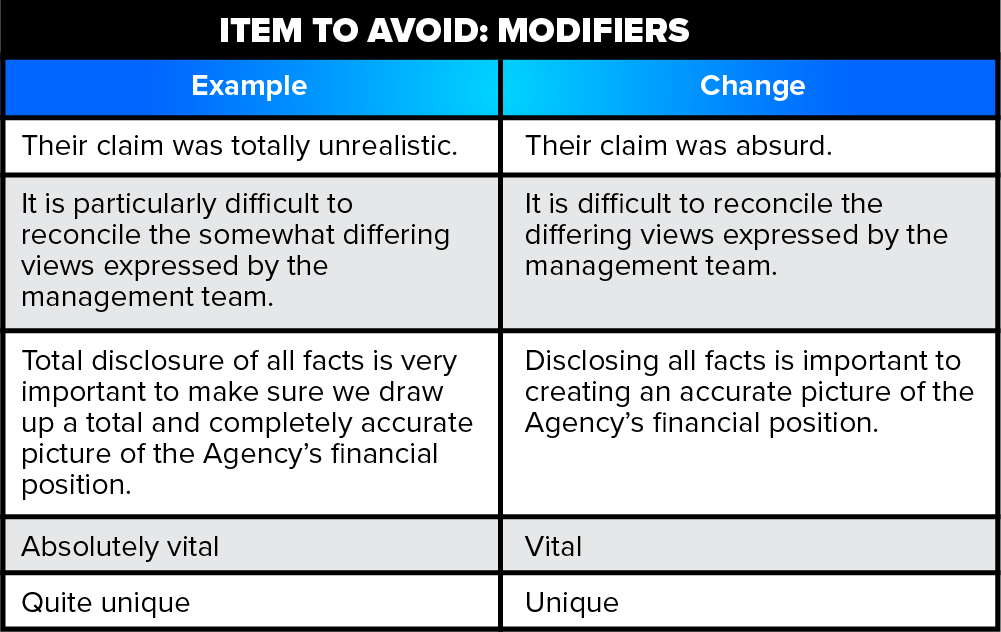
Check for Prepositions
A preposition is a word governing, and usually preceding, a noun or pronoun and expressing a relation to another word or element in the clause. For example, “the man on the platform,” “she arrived after dinner,” “what did you do it for?” In your proposal text, watch out for prepositions such as of, to, and on, which often mark phases you can reduce to one or two words.
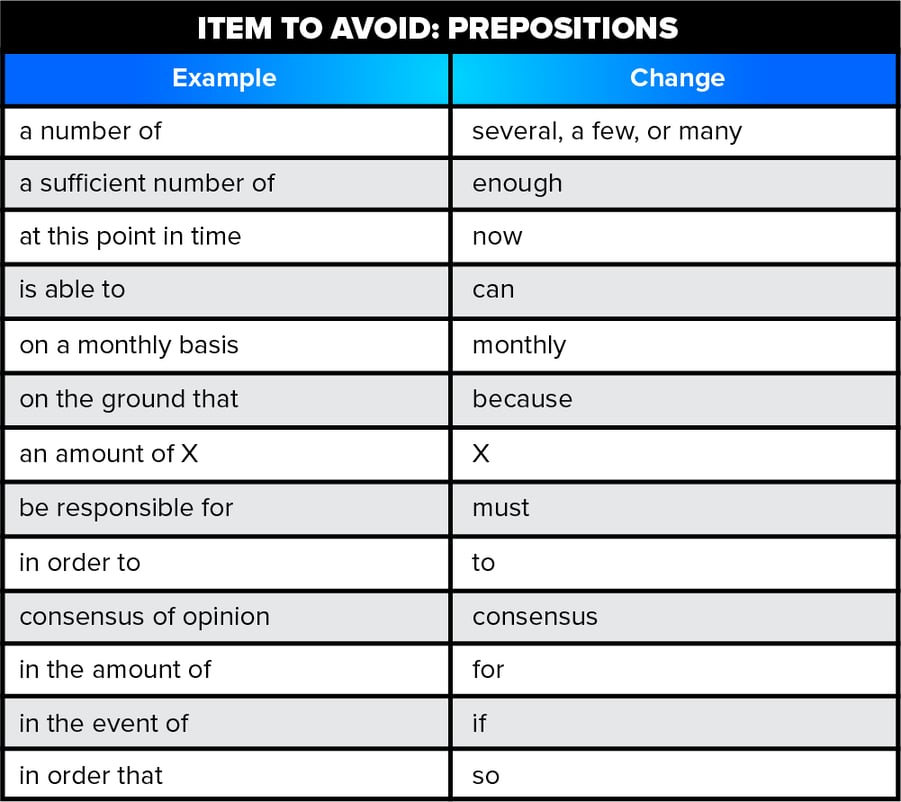
Use Strong Verbs
Another way to make your writing clearer is to express actions in verbs. To do this, you should avoid using nominalizations where possible. Nominalizations are actions expressed in nouns rather than verbs. Examples include failure, investigation, movement, reaction, and refusal. Replacing weak verbs and nominalizations with strong verbs will make your sentences more dynamic, direct, clear, and concise.

3. Use Active Voice
I know you hear this all the time, but active voice really is clearer because it forces you to articulate who is performing the action in the sentence.
Without active voice, you can write an entire proposal and not know who is responsible for performing any of the tasks:
- The Project Management Plan is implemented according to the schedule.
- The systems are transferred over to the new platform.
Passive voice puts the subject and the action first, which can obscure who is performing the action. Passive voice also emphasizes the object of the sentence and can make your writing wordier and harder to follow. With active voice, the subject of the sentence comes first and performs the action in the sentence. Active voice is more straightforward and concise than passive voice. It also typically results in sharper sentences with stronger verbs:
Another surefire way to strengthen your writing is to swap passive voice for active voice. Passive voice puts the subject and the action first, which can obscure who is performing the action. Passive voice also emphasizes the object of the sentence and can make your writing wordier and harder to follow. With active voice, the subject of the sentence comes first and performs the action in the sentence. Active voice is more straightforward and concise than passive voice. It also typically results in shorter, sharper sentences. Active voice also flows better and is easier to understand.
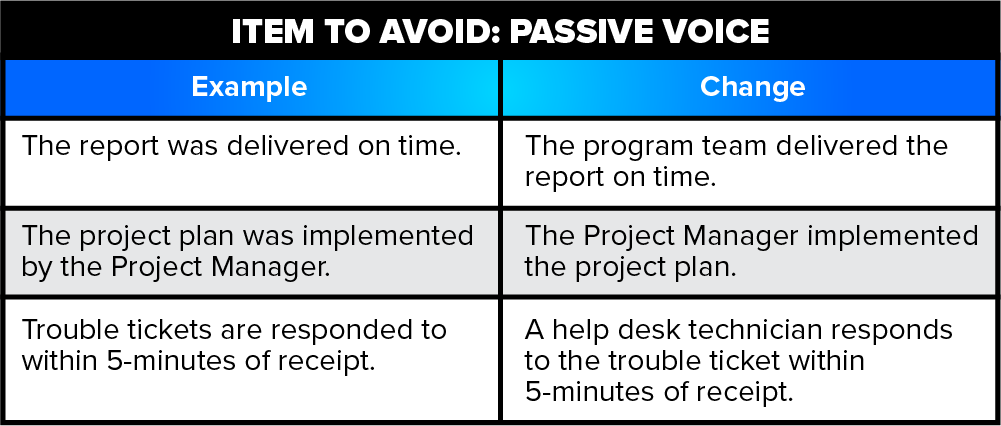
4. Shorten Your Content
Wordy, dense construction is one of the biggest problems in proposal writing.
Nothing is more confusing to the evaluator than long, complex sentences containing multiple phrases and clauses. Unnecessary words also waste the evaluator’s time. Omit information that the evaluator doesn’t need to know and shorten your sentences, paragraphs, and sections.
Shorten Sentences
Research shows that longer sentences are more difficult to digest and understand. Many plain-language advocates—Bryan Garner, Joseph Kimble, Judge Mark Painter, and Wayne Schiess among them—agree that you should keep average sentence length to 20 words or fewer. Most writing analysis tools will score the readability higher when you use shorter sentences and easier to understand words. However, your proposal will flow awkwardly if all sentences are short and choppy.
Therefore, you should aim to vary the length of your sentences. When you see a particularly long sentence, break in to two or even three sentences, depending on the complexity of the message. Breaking up long, complex sentences will help clarify the thought and make it easier for the evaluator to understand and score your response.
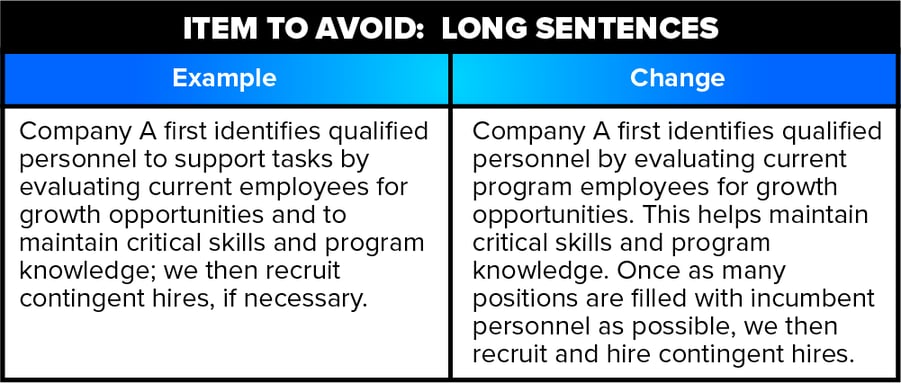
Shorten Paragraphs
Long paragraphs can discourage users from trying to understand your proposal content. Short paragraphs are easier to read and understand. Short paragraphs also open up your writing and create white space.
To improve readability, you should aim to write short paragraphs and cover only one topic per paragraph. According to plainlanguage.gov, writing experts recommend paragraphs of no more than 150 words in three to eight sentences. As with sentence length, if all paragraphs are the same size your writing will be choppy. Vary the lengths of your paragraphs to make them more interesting. This will make your writing more inviting and easier to read.
Shorten Sections and Subsections
Long, dense sections with no white space are not only visually unappealing, they are also difficult for evaluators to weed through and understand. Short sections break up your proposal so it is easier for evaluators to digest and comprehend.
Short sections also help you organize your thoughts more effectively and enable you to use headings and subheadings. When you break up different concepts into short subsections, each heading/subheading gives the reader a clear picture of what’s in that section. This helps the reader skim and scan the page.
5. Leverage Built-In Readability Functions in Microsoft Word
Many people don’t realize that Microsoft Word has built-in functionality to help writers improve the readability of their proposals. In this section we’ll examine:
- Basic spelling and grammar checks
- Editing features that check for readability
- Built-in readability tests and scores
Basic Spelling and Grammar Checks
So frequently when we have been staring at our work for days or weeks, our brains read the content how we think it should read rather than how it actually reads. This can cause us to overlook misspellings, typos, and basic grammar errors. Word’s basic spelling and grammar check function can help us identify these distracting mistakes.
But take care to review the recommendations and use judgment before applying Word’s recommendation. Because it is built on an algorithm, Word’s spelling and grammar recommendations are not always correct.
Click on the Editor icon to access Word’s basic spelling and grammar check function.

Then you can click on each item in the Editor window to walk through Word’s suggestions.
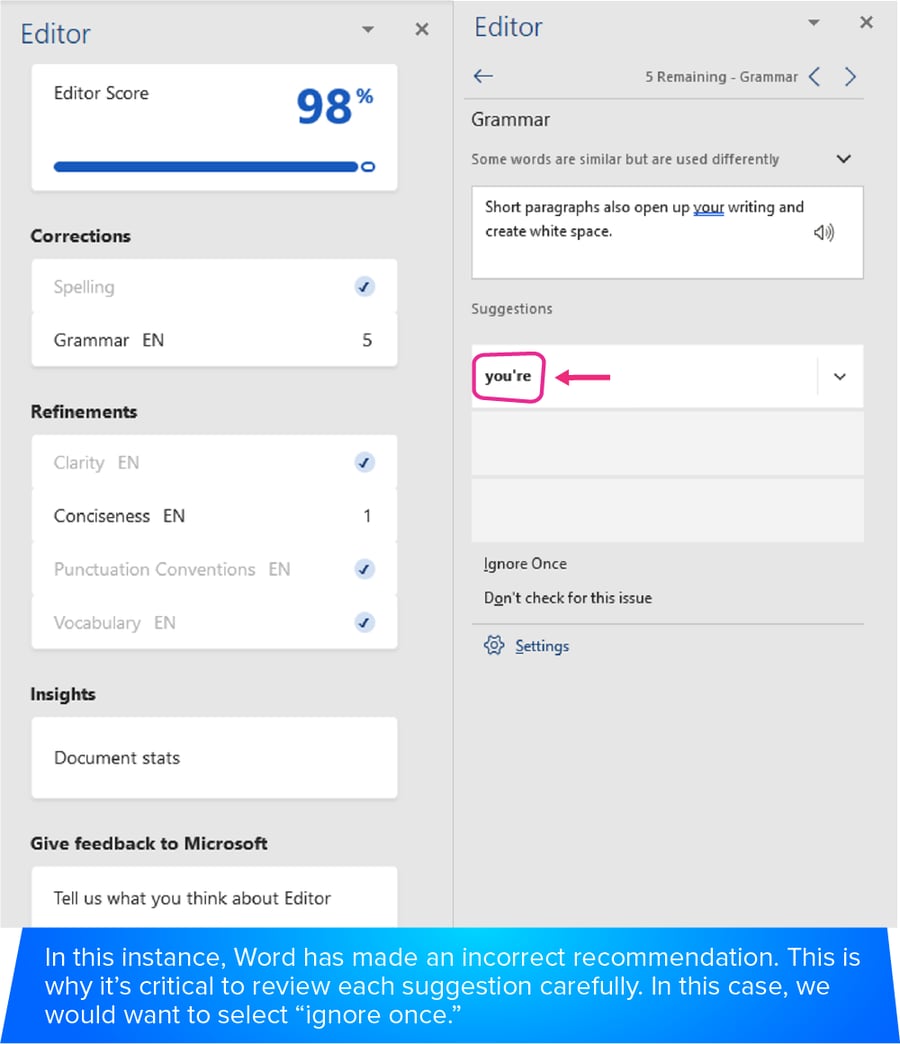
Advanced Editing Features that Check for Readability
In addition to the basic spelling and grammar checks, Word has advanced options built into the editing function to check for additional areas that will improve readability. To activate these functions, follow these steps within Word:
- Click File
- Select Options
- Click Proofing
- Click Settings
- Select Desired Proofing
When you run the Editor to check for spelling, writing, and grammar suggestions, Word will check for all of the items selected.
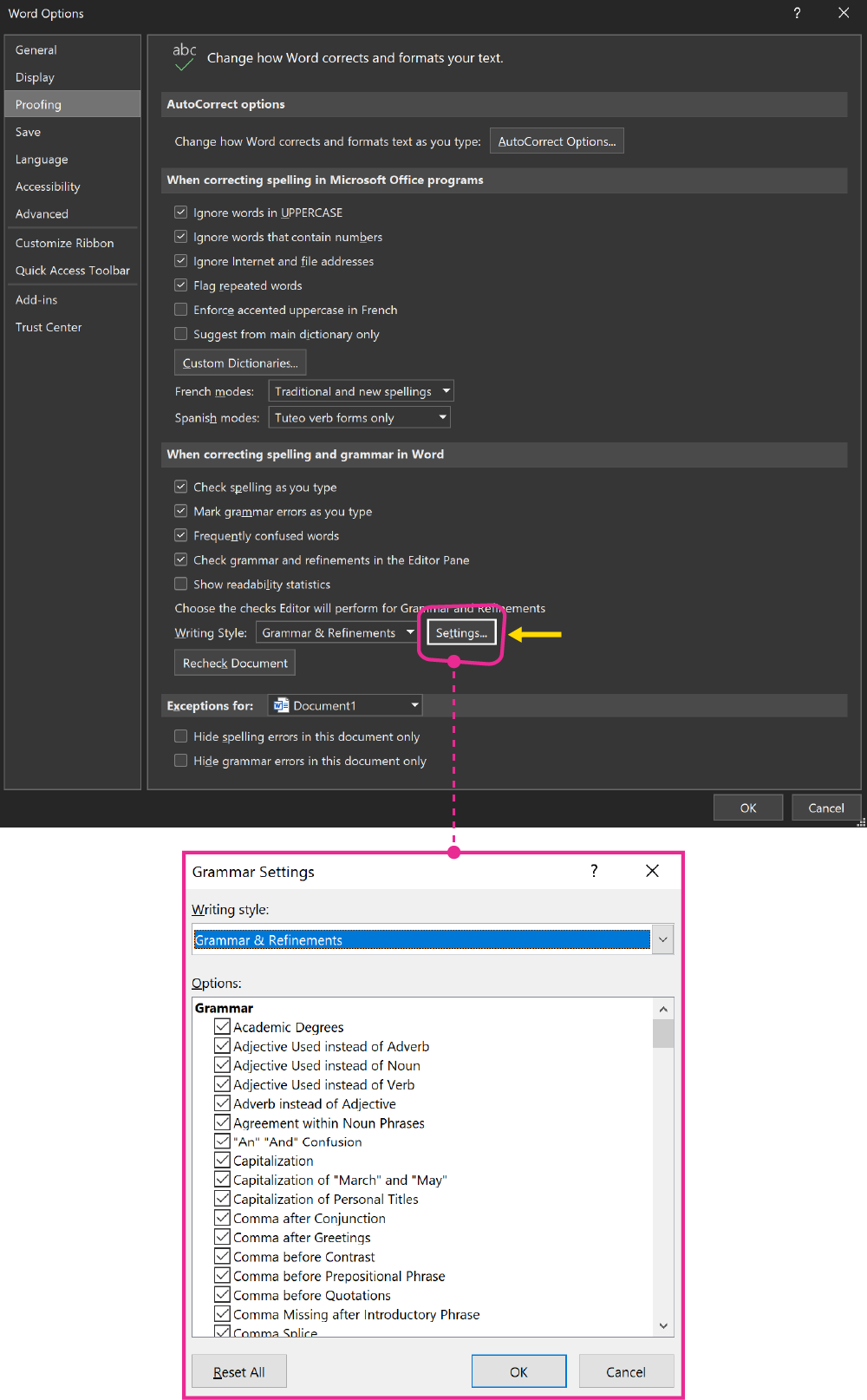
Built-In Readability Test and Scores
When Word finishes checking the spelling and grammar and errors corrected, you can choose to display information about the reading level of the document, including readability scores according to the Flesch-Kincaid Grade Level test and Flesch Reading Ease test. To set up your document, follow these steps within Word:
- Click File, and then click Options
- Click Proofing
- Under When correcting and spelling grammar in Word, make sure the Check grammar with spelling check box is selected
- Select the Show readability statistics check box
Each readability test bases its rating on the average number of syllables per word and words per sentence. The following sections explain how each test scores your file's readability.
Flesch Reading Ease. Microsoft Word’s Flesch Reading Ease score is based on a formula developed in 1949 by Rudolf Flesch. This score is computed using:
- Average number of syllables per word, which measures word difficulty
- Words per sentence, which is an indicator of syntactic complexity
The Flesch Reading Ease score rates the text on a scale of zero to 100. The higher the score, the easier it should be to understand the document. Zero to 40 is very difficult to difficult reading. Eighty and above is easy to very easy. Flesch himself set the minimum score for plain English at 60. As a rule of thumb, you should aim for a score between 60 and 70.

Flesch-Kinkaid Grade Level. Word’s other readability score is the Flesch-Kincaid Grade Level. That score is based on research conducted by J. Peter Kincaid in the mid-1970s. Kinkaid reformulated the Flesch test to produce a formula for computing a text’s reading grade level.
The Flesch-Kinkaid Grade Level score rates text on a U.S. school grade level. For example, a score of 7.0 means that a seventh grader should be able to understand the document. For most proposals, you should aim for a score of approximately 7.0 to 8.5. These scores are similar to what you might find in common newspapers, such as The New York Times.

Considerations. Remember that these are just tools to help guide you. No mathematical formula can truly measure readability. For example, James Joyce’s Ulysses scores somewhat easier to read than Beatrix Potter’s The Tale of Peter Rabbit on the Flesch Reading Ease and Flesch-Kincaid Grade Level tests. Additionally, because the formulas are based on word counts and syllable counts, scrambling the words within in a sentence will not change its readability scores. So do not rely on these tests alone. Consider other factors such as tone, approach, organization, and design.
Final Thoughts
Poorly written, unclear proposals can obscure your message and make it difficult for evaluators to follow your proposal’s logic and main points. If you’re unclear in your writing, the customer can only assume that your communication will be similarly unclear in your contract delivery.
Following these tips can help you to present your ideas more clearly so that evaluators can understand and more easily score your proposals. In addition to making our proposal easier to score, clear writing can contribute to our company’s credibility in the eyes of the evaluator—which can certainly help improve your chances of winning overall.



